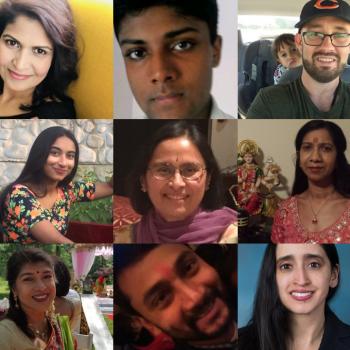A woman known as Gurumayi Chidvilasananda is the current leader of the Siddha Yoga tradition.
Background
The path was founded by Swami Muktananda based on teachings from his guru Bhagawan Nityananda. It was in 1975 that Muktananda began opening ashrams and schools in America.
Gurumayi started in the tradition as a child in India. Her parents brought her and her brother to study with Muktanada in the 1950s. By 14 she had her official initiation (“shaktipat”) and she lived at the ashram. Muktananda named both she and her brother co-successors in 1982.
After Muktananda’s death there was a falling out between brother and sister. It is unclear what happened. One side claims that Gurumayi’s brother left of his own volition to create his own school. The other says that Gurumayi forced her brother out.
Teaching
The vision statement of Siddha Yoga is: “For everyone, everywhere, to realize the presence of divinity in themselves and creation, the cessation of all miseries and suffering, and the attainment of supreme bliss.”
Siddha Yoga offers lectures, chanting, meditation, and many of the other hallmarks of Hindu schools. They have a focus on awakening the “kundalini power” within.
Muktananda believed that the path he learned from was the most ideal because it embraced and used all the traditional yogic disciplines.
It is heavy on devotion and on using sound to vibrate one’s self into a good place (i.e., heavy emphasis on meditation, singing, and chanting). Its teachings are based on Vedanta.
My Experience
I discovered this school when I was in college. I don’t know if they still do it, but at the time there was an available correspondence course, which I signed up for. I would receive a six page letters on a regular basis and the instructions were to read it over and over and over, letting the words sink in beneath conscious thought.
I enjoyed the correspondence course a lot. The teachings were very similar to what I had been brought up with and I found it comforting and blissful.
An event was offered in the area a short time later and I signed up to go. With a small group of other college students, I went to a meditation retreat to have my kundalini energy awakened. It was meditation for much longer than I was used to doing! They claimed that one could not spiritually progress until this kundalini at the base of the spine was woken up, though the tradition I had back home said that the act of meditation itself unlocked kundalini.
I found the retreat a bit uncomfortable. It was so close to what I was used to, but slightly off. The reverence with which people bowed to images of the guru disturbed me (This just happens to be a trigger for me and it is not at all unusual for Hindu schools to teach high devotion to the guru. I require knowing a guru very well before giving him or her deference).
Back on campus I went to a few meetings with the Siddha Yoga group of kids, but I really didn’t like it. I soon stopped going. Sometime after that I heard some criticisms of the Siddha Yoga path, though I have no personal experience of that.
I find that I am ill at ease with how similar this school is to the one I grew up in. Whatever criticisms or praise there are for Siddha Yoga, I think most of the same are said of the organization I grew up with (whether justified or not, I don’t know). The locations, teachings, etc. are eerily similar. I wouldn’t be surprised if people hearing that I grew up in an Americanized Hindu organization would assume it was this one. It was not. One of these days I will do a post on my own organization. (And I did!)
***
There has been a lot of speculation that the Siddha Yoga organization is the one that Elizabeth Gilbert followed in writing her book Eat, Pray, Love, though that has never been officially confirmed. The evidence is pretty strong for it, though:
But if you’re somewhat familiar with India’s spiritual landscape, it’s easy to figure out that this “feminine, multilingual, university-educated” guru is Gurumayi Chidvilasananda — the head of the SYDA. For starters, India doesn’t have very many female gurus, and fewer still that speak impeccable English and reside in the United States. Gilbert also dedicates a sizable chunk of the India portion of her book to the troubles she has with the “Gurugita,” an obscure 90-minute-long hymn that Gurumayi’s devotees are required to chant every morning. –Salon.com
Learn More
* I am not endorsing any of the teachers highlighted in this feature















